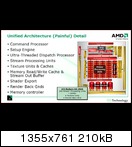I've written about this before: it's delusional to expect much higher clock speeds in the day and age, unless you also accept a completely new architecture. Current assumptions are that RV770 is on 55nm just like RV670 and that it's an evolution of the same architecture. If that's the case, then there is simply no way the clock is going to be increased a lot. Even if it's the same architecture and on, say, 45nm, I still wouldn't expect much. All the numbers that are going around in the industry indicate that you'll save area and a bit of power, but the era of free speed upgrades is largely over. (Remember those utopian speculations about a 2GHz+ shader clock that some people thought was credible?)
One of the important points to realize is that it's not just 1 or 2 blocks in the whole chip that are limiting the overall clock speed. Closing timing at 800MHz with standard cells is *hard*, no matter which functional block you're talking about. Every designer of every block is designing against the same clock speed specification and all of them struggle to make it, iterating for weeks or months to shave picoseconds from the critical path. So upping the spec from 800 to 900 is a monumental affair that amounts to touching pretty much every block in the chip. For a company with limited resources (all of them) it'd be incredibly foolish to spend time on this, when they should be working on their next major architecture.


